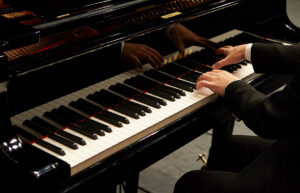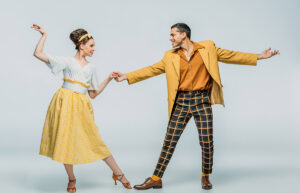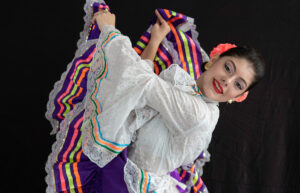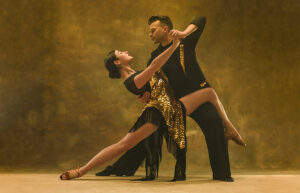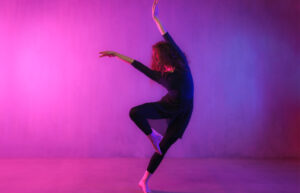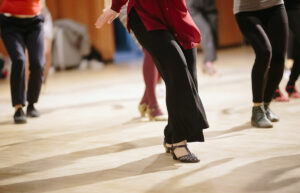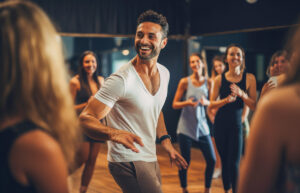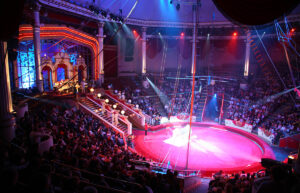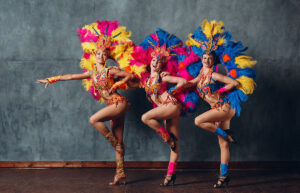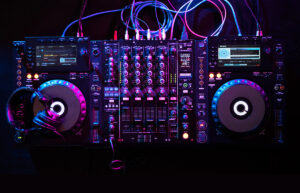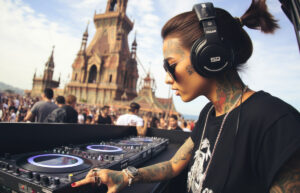A Step-by-Step Guide to Becoming a Dancer

Becoming a dancer is an exhilarating pursuit filled with passion, creativity, and self-discovery. To be awarded the Best Dancer in the World in the competitive dance world, one must master the art form and exhibit the traits of self-control, imagination, and teamwork. In this comprehensive guide, we’ll navigate the steps to mastering the art of dance, from laying the foundation to stepping confidently onto the stage. Explore how to become a professional dancer, what dance career to pursue, the steps to become a professional dancer, and the skills required to have a professional dancing career.
Welcome to TheDemoStop, now join the community!
Connect with artists, fans and producers around the world.
What is a dancer?
A dancer expresses themselves through rhythmic and coordinated movements, typically to music. It’s a beautiful way to convey emotions, tell stories, and showcase physical skill and artistry.
Dance can take many forms, from traditional cultural dances to modern choreography. Whether it’s ballet, hip-hop, salsa, or any other style, dancing is a universal language that transcends boundaries.
Personal requirements for a dancer
- Discipline, dedication, and perseverance
Dancers must be disciplined in their training routines, consistently dedicating time to practice and refine their skills. Perseverance is crucial for overcoming challenges and pushing through the demanding aspects of dance.
- Physically flexible
Dance often requires a wide range of motion and flexibility.
- Good sense of rhythm
A dancer’s ability to move in sync with the beat is essential. It helps in creating visually appealing and harmonious choreography.
- An appreciation of music
Understanding and appreciating music is fundamental for a dancer. It allows them to connect with the rhythm, interpret the mood, and express themselves more effectively.
- High-level technical and interpretive skills
Technical skills involve mastering specific dance techniques, such as hip-hop or contemporary, while interpretive skills enable dancers to convey emotions and tell stories through their movements. Both are crucial for a well-rounded performance.
- Good general health and fitness
Dance is physically demanding, requiring stamina, strength, and cardiovascular fitness. Good health and fitness contribute to a dancer’s ability to perform at their best.
- Good communication skills
Communication in dance goes beyond words. Dancers need to effectively convey emotions and messages through their movements, creating a connection with the audience.
Education and training for a dancer
Education and training are vital for a dancer’s development. Some opt for formal education in dance through high school programs, performing arts schools, or specialized academies, providing structured curricula covering theory and practice. A Bachelor’s degree in dance from college or university offers comprehensive education in history, choreography, anatomy, and techniques.
Specialized training refines skills in specific styles or techniques through workshops, masterclasses, and training under esteemed instructors. Practical experience in recitals, showcases, and performances builds stage confidence.
Internships with dance companies offer hands-on experience, working alongside industry professionals for valuable insights. Continuing education keeps dancers updated in the dynamic dance world.
Networking within the community is crucial for collaboration and career opportunities. These aspects collectively contribute to a dancer’s well-rounded development.
What does it take to be a dancer?
Headshots
High-quality photographs capturing a dancer’s face and upper body serve as their visual introduction, conveying personality and physical presence. These images are essential for auditions, promotional materials, and online profiles.
Dance Resume
A detailed document outlining a dancer’s professional and educational background, including training history, performance experience, mastered dance styles, and relevant achievements. It provides a quick overview for directors and choreographers, crucial for auditions and networking.
Dance Reel
A visual portfolio featuring recorded performances that showcase a dancer’s proficiency and versatility across various styles. This compilation of clips highlights technique, stage presence, and adaptability, making it a potent self-promotion tool for auditions and online profiles.
Welcome to TheDemoStop, now join the community!
Connect with artists, fans and producers around the world.
How to become a dancer?
Getting started in dance
- Choose a style: Decide on the type of dance you want to pursue. Whether it’s ballet, hip-hop, contemporary, or any other style, find what resonates with you.
- Find a studio or class: Look for local dance studios or classes in your community through community centers, dance schools, or online platforms.
- Basic gear: Invest in the basic dance attire and shoes for your chosen style. These gear might include leotards, tights, ballet shoes, or sneakers.
- Commitment and consistency: Like any skill, regular practice is key. Attend classes consistently and practice at home to improve your technique and muscle memory.
Develop your skills & conditioning.
- Technique training: Focus on mastering the fundamental techniques of your chosen dance style, including body alignment, footwork, and coordination.
- Strength and flexibility: Dance requires physical fitness. Incorporate strength training and flexibility exercises into your routine to enhance performance and prevent injuries.
- Cross-training: Explore other forms of exercise to complement your dance training, such as yoga, Pilates, or cardio workouts to build stamina and endurance.
- Seek feedback: Don’t be afraid to ask for constructive feedback from your instructors. It will help you identify improvement areas and refine your skills.
Build experience & pursue additional training.
- Performance opportunities: Participate in recitals, showcases, or local performances to gain stage experience. These experiences will build confidence and expose you to different aspects of the dance world.
- Networking: Connect with other dancers, choreographers, and professionals in the dance community. Networking can open up opportunities for collaboration and further training.
- Advanced classes or workshops: As you progress, consider taking advanced courses or seminars to challenge yourself, learn new techniques, and keep your skills sharp.
- Consider professional training: If dance is more than a hobby for you, explore the possibility of formal training in a dance school or conservatory to develop a belonging of the art of dance.
Skills needed to become a dancer
Collaboration
Dancers often work in groups or with choreographers, requiring strong collaboration skills. The ability to communicate effectively, listen to others’ ideas, and seamlessly blend with fellow dancers is crucial for creating cohesive and visually stunning performances.
Technical knowledge
Dancers must master the technical aspects of their chosen genre, whether it is ballet, hip-hop, contemporary, or any other form. Technical knowledge includes understanding body mechanics, proper form, and the execution of specific movements.
Adaptability
Dance is a dynamic art form, and dancers must be adaptable to different styles, choreography, and performance environments. Whether adjusting to a new routine, collaborating with other artists, or performing in various venues, adaptability allows dancers to navigate the diverse challenges of the dance world.
Creativity
While technical proficiency is crucial, creativity sets exceptional dancers apart. Dancers should infuse their movements with emotion, expression, and a unique artistic flair. Creative thinking allows them to contribute to the choreographic process, bring characters to life, and connect with audiences on a deeper level.
Coordination
Exceptional coordination is a fundamental skill for dancers. It involves synchronizing movements with music, fellow dancers, and the overall choreography. Precise coordination ensures that the dancer’s body movements are fluid, controlled, and visually compelling, contributing to the overall aesthetics of the performance.
How much do dancers earn?
The mean salary for a dancer is $37,697; however, the job generally offers employment between $33,439 and $41,997. Factors such as professional experience, education, certifications, and additional competencies significantly influence the magnitude of salary.
Welcome to TheDemoStop, now join the community!
Connect with artists, fans and producers around the world.
16 steps guide to becoming a good dancer
Get motivated
Find inspiration and motivation to fuel your passion for dance. Whether by watching performances, attending dance events, or connecting with like-minded individuals, motivation is the driving force behind improvement.
Stretch and warm up
Prioritize physical preparation to prevent injuries. Regular stretching and warm-up routines enhance flexibility, mobility, and physical readiness for dance.
Study music
Understand the intricacies of music. Recognize beats, rhythms, and musicality to synchronize your movements effectively with the music.
Learn basics and grooves
Master the foundational dance moves and grooves. These basics serve as the building blocks for more advanced choreography and styles.
Attend dance classes
Enroll in formal dance classes to receive structured training, guidance from instructors, and opportunities for constructive feedback.
Technique and execution
Focus on refining your technique and executing movements with precision. Technical proficiency enhances the quality of your performance.
Learn to dance with feeling
Infuse emotion and expression into your movements. Dance with feeling to connect with the music and your audience more deeply.
Explore through freestyle
Practice freestyle dancing to enhance creativity, spontaneity, and the ability to adapt to different styles.
Create your choreography
Develop the skill of choreographing your routines to showcase your unique style and artistic vision.
Find what makes you unique
Identify your strengths, personal style, and unique attributes as a dancer.
Keep a growth mindset
Accept the challenges, ask for feedback, and view setbacks as opportunities for growth.
Kill it on stage
Develop stage presence and confidence. Own your performances with charisma and an emphatic connection to the audience.
Become a leader
Cultivate leadership qualities within the dance community. Inspire others, contribute ideas, and take on responsibilities to elevate your role.
Collaborate with others
Engage in collaborative projects to broaden your dance experience. Working with others enhances creativity and exposes you to different perspectives.
Share your work
Showcase your talent through performances, social media, or dance platforms. Sharing your work builds visibility and connections within the dance community.
Take care of your body
Prioritize physical well-being. Maintain a balanced diet, stay hydrated, get enough rest, and promptly address injuries to sustain a long and healthy dance career.
Key steps to pursue a career as a dancer
Step 1: Start early and develop a foundation
Begin your dance journey early, focusing on building a solid foundation in basic techniques and movements. Starting early allows for more extensive skill development over time.
Step 2: Expand your training
Diversify your training by exploring various dance styles and techniques. Exposure to different forms of dance enhances versatility and broadens your skill set.
Step 3: Pursue a dance education
Consider formal dance education through high school programs, performing arts schools, or colleges. A structured dance education provides comprehensive knowledge and a recognized qualification.
Step 4: Attend auditions and workshops
Actively participate in auditions for dance productions or companies. Attend workshops and masterclasses to learn from experienced choreographers and gain exposure to different dance styles.
Step 5: Build performance experience
Gain valuable experience by performing in local shows, recitals, or community events. Building a performance portfolio showcases your skills and establishes your presence in the dance community.
Step 6: Seek professional training programs
Explore professional training programs or intensives offered by renowned dance institutions or companies. These programs provide intensive training and exposure to industry professionals.
Step 7: Network and collaborate
Establish connections within the dance community by networking with fellow dancers, instructors, and choreographers. Collaborating on projects enhances your visibility and opens doors to new opportunities.
Welcome to TheDemoStop, now join the community!
Connect with artists, fans and producers around the world.
Step 8: Create a professional portfolio
Develop a professional portfolio showcasing your dance experiences, education, and achievements. Include headshots, a dance resume, and a reel of your performances to present a comprehensive overview of your capabilities.
Step 9: Continuously train and improve
Embrace a mindset of continuous learning. Engage in regular training sessions, workshops, and classes to refine your skills, stay updated on industry trends, and continuously improve as a dancer.
Step 10: Audition and seek opportunities
Actively audition for dance productions, companies, or projects. Pursue opportunities that align with your goals and allow you to showcase your talent on larger platforms.
Step 11: Stay physically and mentally healthy
Prioritize your overall well-being by maintaining physical fitness, addressing injuries promptly, and nurturing mental health. A healthy dancer is better equipped to handle the demands of a professional career and sustain longevity.
Helpful resources available for dancer
Dance organizations and associations
Connect with reputable dance organizations and associations such as the International Dance Council (CID) or the Dance USA. These organizations provide valuable resources, networking opportunities, and support for dancers.
Dance publications and magazines
Explore industry trends, news, and insights by exploring dance publications and magazines like Dance Magazine, Pointe Magazine, or Dance Spirit. These resources offer articles, interviews, and reviews relevant to the dance community.
Dance festivals and conventions
Attend dance festivals and conventions like Jacob’s Pillow Dance Festival or the Dance Teacher Summit. These events provide opportunities to learn from renowned choreographers, attend workshops, and network with professionals in the field.
Online platforms and communities
Join online dance platforms and communities such as DancePlug, Dance.com, or Dance.net. These platforms offer a virtual space to connect with other dancers, share experiences, and access online classes and resources.
Professional dance companies and studios
Explore opportunities with professional dance companies and studios. Many companies offer training programs, workshops, and auditions. Being associated with reputable companies can enhance visibility and open doors to professional opportunities.
Scholarships and grants
Research dance scholarships and grants offered by organizations like the National Endowment for the Arts or the American Dance Festival can support your education, training, or participation in dance programs.
Dance-related websites and blogs
Explore dance-related websites and blogs for informative content and insights. Websites like Dance Informa or Dance Advantage provide articles, tips, and advice for dancers at various stages of their careers.
Four main career paths for dancers
Freelance dancer
- Work independently as a freelance dancer, taking on projects with various choreographers, companies, or events.
- Enjoy flexibility in choosing the type of performances, styles, and collaborations that align with personal preferences.
- Manage your schedule and negotiate contracts for specific dance engagements.
- It may involve performing in commercials, music videos, or joining temporary dance groups for particular productions.
Company dancer
- Join a professional dance company and become a full-time member of a structured and established group.
- Engage in regular rehearsals, performances, and tours as part of the company’s productions.
- Benefit from a consistent salary, health benefits, and the opportunity to work with renowned choreographers.
- Contribute to the artistic vision of the company while being part of a cohesive and dedicated dance ensemble.
Dance instructor
- Share your expertise by becoming a dance instructor, independently or affiliated with a dance studio or school.
- Teach a variety of dance styles to students of different skill levels, from beginners to advanced.
- Develop curriculum, plan lessons, and inspire students to develop their skills and passion for dance.
- It may involve teaching in academic institutions, community centers, or private studios.
Choreographer
- Take on the role of a choreographer, creating original dance routines and performances.
- Collaborate with dancers, directors, and other creative professionals to bring your artistic vision to life.
- Work on a freelance basis, creating pieces for various projects, or become an in-house choreographer for a company.
- Showcase your unique style and creativity through choreographed sequences for stage productions, music videos, or other artistic endeavors.
Welcome to TheDemoStop, now join the community!
Connect with artists, fans and producers around the world.
Conclusion
What is a dancer?
A dancer is an artist who uses rhythmic body movements to convey emotions and stories along with music.
Personal requirements for a dancer:
- Discipline, dedication, and perseverance
- Physically flexible and well-proportioned
- Good sense of rhythm
- An appreciation of music
- High-level technical and interpretive skills
- Good health and high levels of fitness
- Good communication skills
Education and training for a dancer
- Seek formal education in dance through high school programs, performing arts schools, or dance academies.
- Pursue a Bachelor’s degree in dance.
- Take specialized training in a particular dance form.
- Get experience through recitals, showcases, and performances.
- Join internships and apprenticeships with professional dance companies.
- Continuing education through workshops, masterclasses, or training under renowned choreographers and instructors.
- Networking with other artists, choreographers, and companies.
What does it take to be a dancer?
- Headshots: Professional photographs showcasing your appearance.
- Dance resume: Summary of training, experience, and skills.
- Dance reel: Video compilation highlighting your dance performances.
How to become a dancer?
- Getting started in dance: Begin with introductory dance classes to explore styles.
- Develop your skills & conditioning: Focus on mastering techniques and maintaining physical fitness.
- Build experience & pursue additional training: Participate in performances, seek workshops, and continuously train.
Skills needed to become a dancer
- Collaboration
- Technical knowledge
- Adaptability
- Creativity
- Coordination
How much do dancers earn?
The salary of a dancer ranges between $33,439 and $41,997 in a year.
16-step guide to becoming a good dancer:
- Get motivated: Find inspiration to fuel your passion for dance.
- Stretch and warm-up: Prepare your body for movement with proper warm-up.
- Study music: Understand the rhythm and nuances of different genres.
- Learn basics and grooves: Master fundamental dance techniques and unique moves.
- Attend dance classes: Take regular classes to refine your skills.
- Technique and execution: Focus on precise execution of dance techniques.
- Learn to dance with feeling: Infuse emotion into your movements for a compelling performance.
- Explore through freestyle: Experiment and express yourself in freestyle sessions.
- Create your choreography: Develop original dance routines to showcase your style.
- Find what makes you unique: Identify and highlight your distinctive dance qualities.
- Keep a growth mindset: Embrace challenges and view failures as learning opportunities.
- Kill it on stage: Confidently showcase your skills in the performances.
- Become a leader: Take initiative and inspire others in the dance community.
- Collaborate with others: Work with fellow dancers to enhance creativity.
- Share your work: Showcase your performances through various platforms.
- Take care of your body: Prioritize physical and mental well-being for a sustainable dance career.
Key steps to pursue a career as a dancer
- Start early and develop a foundation: Begin dance classes early to build a strong foundation.
- Expand your training: Explore various dance styles and expand your skill set.
- Pursue a dance education: Enroll in a formal dance education program for comprehensive training.
- Attend auditions and workshops: Participate in auditions and seminars to gain exposure.
- Build performance experience: Engage in local performances to enhance your experience.
- Seek professional training programs: Pursue specialized training programs for advanced skills.
- Network and collaborate: Connect with professionals and collaborate with fellow dancers.
- Create a professional portfolio: Develop a portfolio showcasing your achievements and skills.
- Continuously train and improve: Stay dedicated to ongoing training and skill improvement.
- Audition and seek opportunities: Actively audition for dance roles and seek performance opportunities.
- Stay physically and mentally healthy: Prioritize physical and mental well-being for a sustainable career.
Helpful Resources Available for a Dancer
- Dance Organizations: Alvin Ailey American Dance Theater, Broadway Dance Centre
- Dance Publications: Dancing Times, Pointe.
- Dance Festivals: American Dance Festival, Mint Festival, Uthbhav Utsav
- Online Platforms: Dance Plug, Steezy Studio
- Professional Companies: American Ballet Theatre, Axis Dance Company
- Scholarships/Grants: American College Dance Association, George Mason University Dance Talent Scholarship
- Dance Websites/Blogs: Nickelz Production Hip Hop Dance Blog, Steezy, A Dancer’s Life
Four main career paths for dancers
- Freelance dancer: Independent, taking on various projects.
- Company dancer: Full-time member of a dance company.
- Dance instructor: Teaches dance at studios or institutions.
- Choreographer: Creates and designs dance routines.
FAQs
What is a dancer?
A dancer is a performer who uses body movements to express emotions or tell a story through music.
What are the requirements to become a dancer?
- Training: Formal training in dance styles such as ballet, contemporary, hip-hop, etc.
- Physical fitness: Good overall physical condition, flexibility, and stamina.
- Technique: Mastery of dance techniques and styles.
- Creativity: Ability to express emotions and create visually appealing choreography.
- Discipline: Dedication to regular practice and continuous improvement.
- Performance skills: Confidence and stage presence.
- Musicality: A sense of rhythm and understanding of musicality.
- Networking: Building connections within the dance community.
- Resilience: Ability to handle rejections and setbacks in a competitive field.
What does it take to become a dancer?
- Headshots: Professional photographs showcasing the dancer’s appearance.
- Dance resume: Summary of dance training, experience, and skills.
- Dance reel: Video compilation highlighting the dancer’s performances and versatility.
How to become a dancer?
- Getting started in dance
- Take introductory dance classes to explore different styles.
- Identify your preferred dance genres and areas of interest.
- Develop your skills & conditioning
- Focus on building strength, flexibility, and stamina.
- Master fundamental dance techniques through consistent practice.
- Build experience & pursue additional training
- Participate in local performances, recitals, or dance competitions.
- Seek advanced training opportunities and workshops to refine your skills.
What skills are needed to become a dancer?
- Technical proficiency: Mastering dance techniques and movements specific to chosen styles.
- Collaboration: Working well with choreographers, fellow dancers, and other collaborators.
- Adaptability: Flexibility to adapt to different dance styles and choreographic approaches.
- Creativity: Expressing emotions and telling stories through choreography.
- Performance presence: Confidence, stage presence, and the ability to engage an audience.
What are the steps to pursue a career as a dancer?
- Step 1: Start early and develop a foundation.
- Step 2: Expand your training.
- Step 3: Pursue a dance education.
- Step 4: Attend auditions and workshops.
- Step 5: Build performance experience.
- Step 6: Seek professional training programs.
- Step 7: Network and collaborate.
- Step 8: Create a professional portfolio.
- Step 9: Continuously train and improve.
- Step 10: Audition and seek opportunities.
- Step 11: Stay physically and mentally healthy.
How to become a good dancer?
Master fundamental dance techniques, attend regular classes for improvement, explore various styles, practice consistently, focus on musicality, learn choreography precisely, seek feedback, observe professionals, maintain fitness and flexibility, express emotion in movements, perform regularly, and stay persistent in learning and improving.
What is the minimum education for a dancer?
While formal education in dance can be beneficial, it’s not always a strict requirement for a successful career. Many accomplished dancers begin training at a young age and gain expertise through specialized programs, workshops, and practical experience. While some may opt for formal education in dance or related fields, it’s not a mandatory path for a thriving dance career.
How much does a dancer earn?
A dancer can earn somewhere between $33,439 and $41,997 in a year.
What are the career paths for a dancer?
Here are some career paths for a dancer:
- Freelance dancer
- Company dancer
- Dance instructor
- Choreographer




